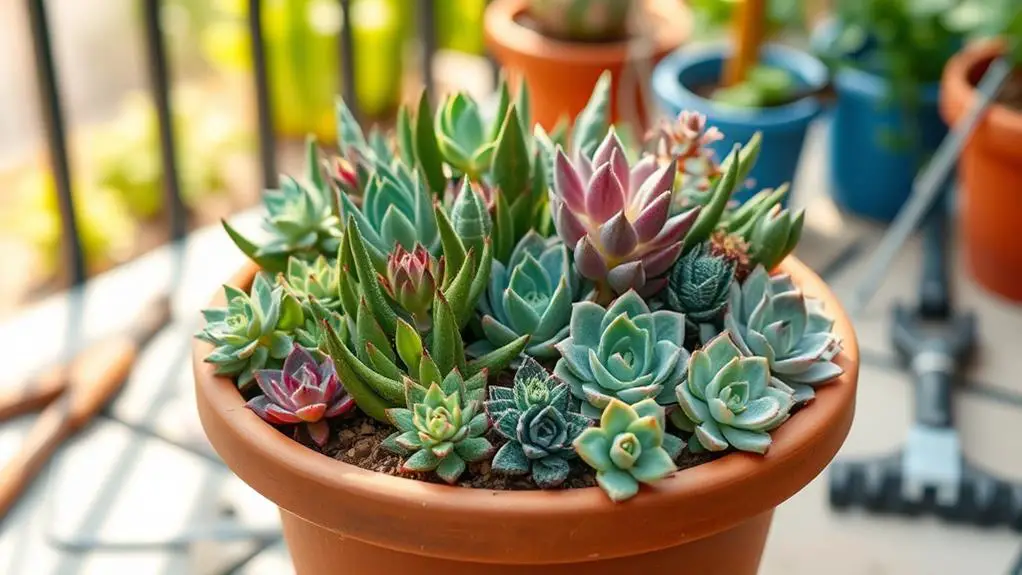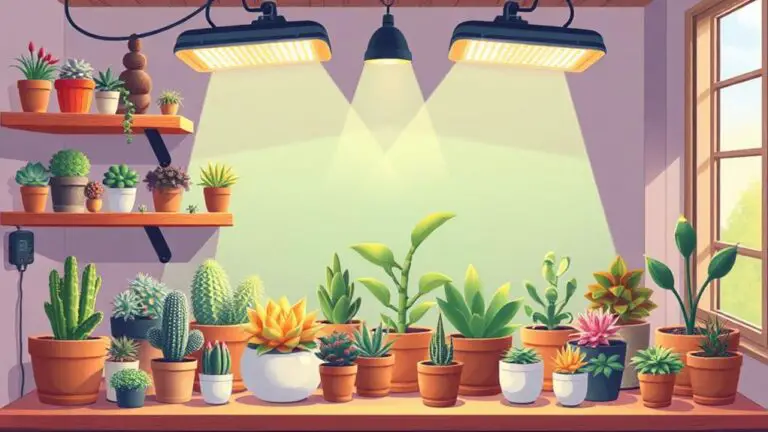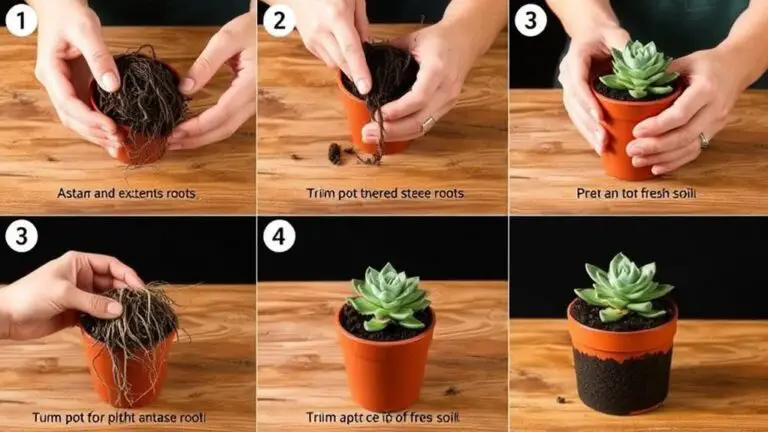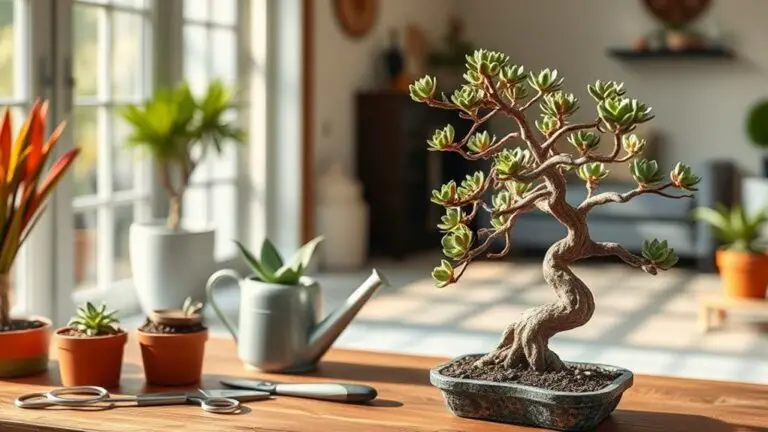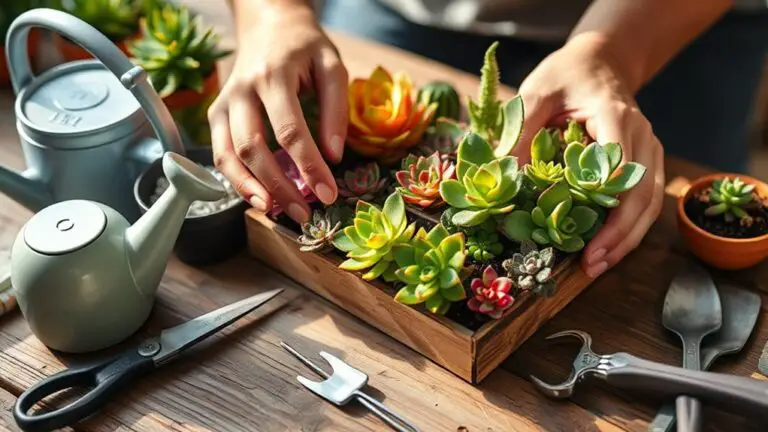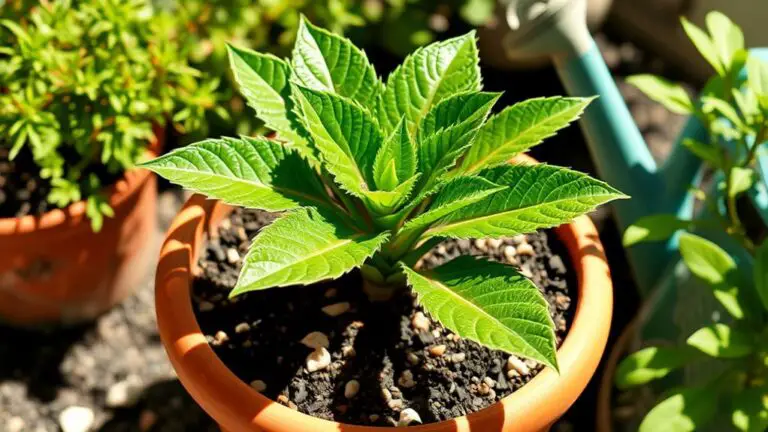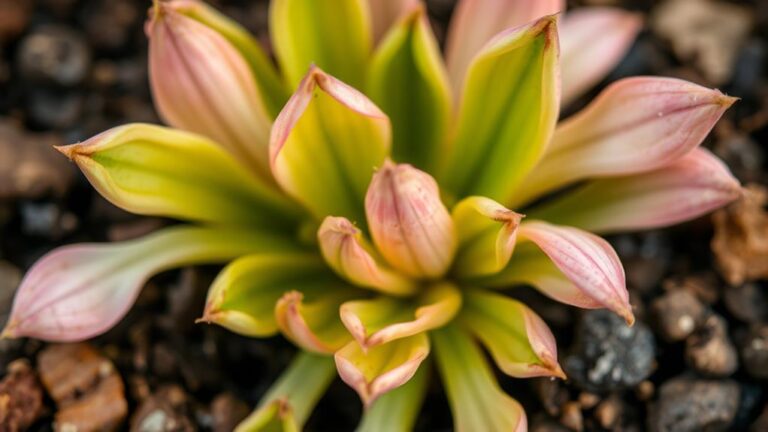How Close Should You Plant Succulents?
When you're deciding how close to plant your succulents, the season and their growth stage play significant roles. During spring and summer, spacing them 0.5 to 1 inch apart helps prevent resource competition, ensuring each plant gets enough water, nutrients, and sunlight. However, in fall and winter, closer planting might work better due to their dormancy phase. The right spacing not only boosts their health but also enhances the visual appeal of your arrangements. So, how do you balance these factors for ideal growth and aesthetics? Let's explore further.
Seasonal Growth Patterns
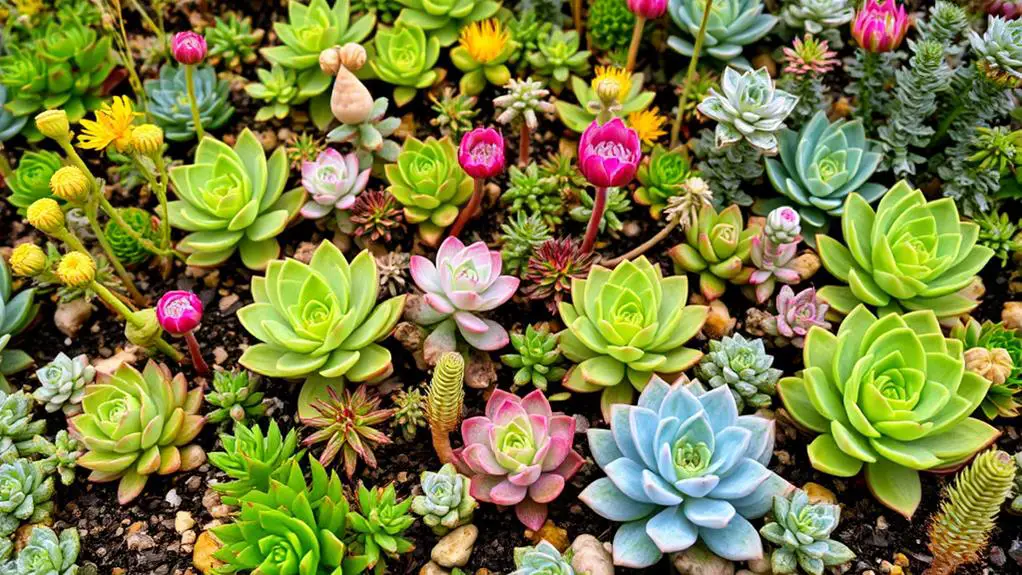
During spring and summer, succulents burst into active growth, making it vital to carefully plan their spacing. You'll notice your plants expanding quickly during these warmer months, and this is when their seasonal growth patterns are most evident.
To guarantee healthy expansion, you should aim for ideal spacing of half to one inch between each succulent. This helps prevent root crowding, which can stunt their development.
Spring and summer are significant times for your succulents. If they're planted too close together, they'll compete for water, nutrients, and sunlight. This competition can lead to weaker and less vibrant plants.
By giving each succulent a bit of breathing room, you're setting the stage for robust growth and a visually appealing arrangement.
During the dormant phase, which occurs in fall and winter, succulents don't grow as much. This allows for closer planting without negative effects.
However, the spacing you establish in spring and summer will carry them through their active growth period.
Dormancy and Spacing
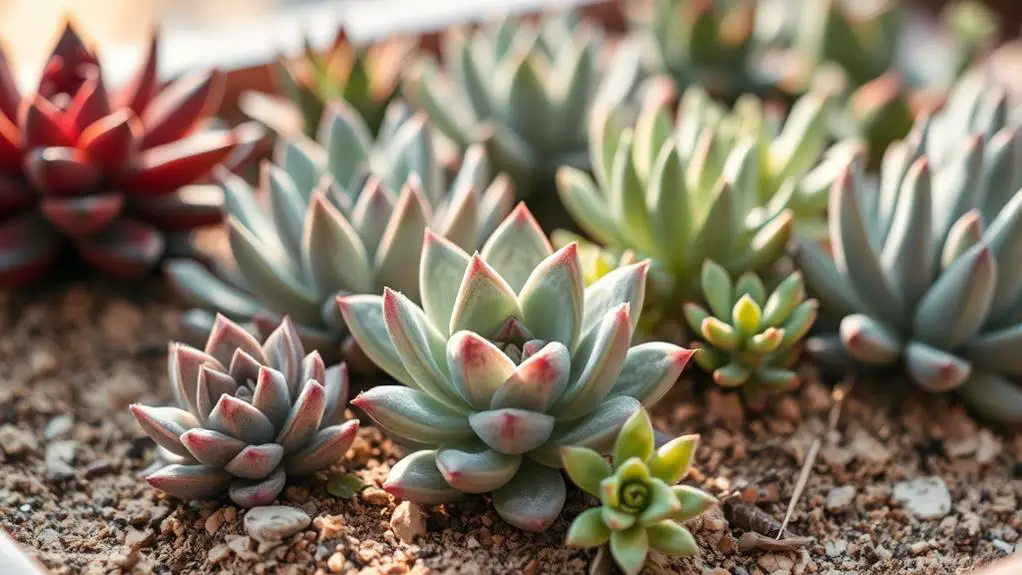
As the active growing season winds down, it's important to understand how dormancy affects your succulents' spacing needs. During fall and winter, most succulents enter a dormant phase. This is when they conserve energy and their growth slows down considerably.
Because of this, you can plant them closer together without worrying about them outgrowing their space. Providing half to one inch of spacing between each succulent during dormancy is ideal. This small gap allows for some growth when the active season returns but keeps things visually appealing in the meantime.
Plus, the crowded arrangement can give your succulent display a more finished look, making it more attractive. Overcrowding isn't a concern during dormancy because the plants aren't actively growing. This means they won't compete for resources, ensuring their long-term health.
Think of it as giving them a cozy winter retreat to rest and gather energy for the next growing season.
Crowded Growth Rates

When succulents are planted closely together, their growth rates can slow down due to competition for crucial resources like soil, moisture, and nutrients. You might think that packing them tightly looks nice, but it can actually affect their healthy growth.
Imagine them as goldfish in a small bowl—too many, and they won't thrive.
Planting succulents close together means they'll compete for:
- Soil: Each plant needs enough soil to anchor its roots and access nutrients.
- Moisture: Crowded arrangements can make it hard for water to evenly reach all the roots.
- Nutrients: Limited nutrients can stunt their growth and reduce their liveliness.
- Space: Root-bound conditions can occur, halting growth but not harming the plants.
- Light: Tight spacing might block light, reducing the energy each plant gets.
To balance aesthetics and health, give your succulents about half to one inch of space. This helps them access what they need without being too crowded.
Keep an eye on them, especially during the active growth phases in spring and summer. By monitoring plant health, you'll guarantee your succulents stay vibrant and beautiful, even in crowded arrangements.
Tips for Crowded Planting
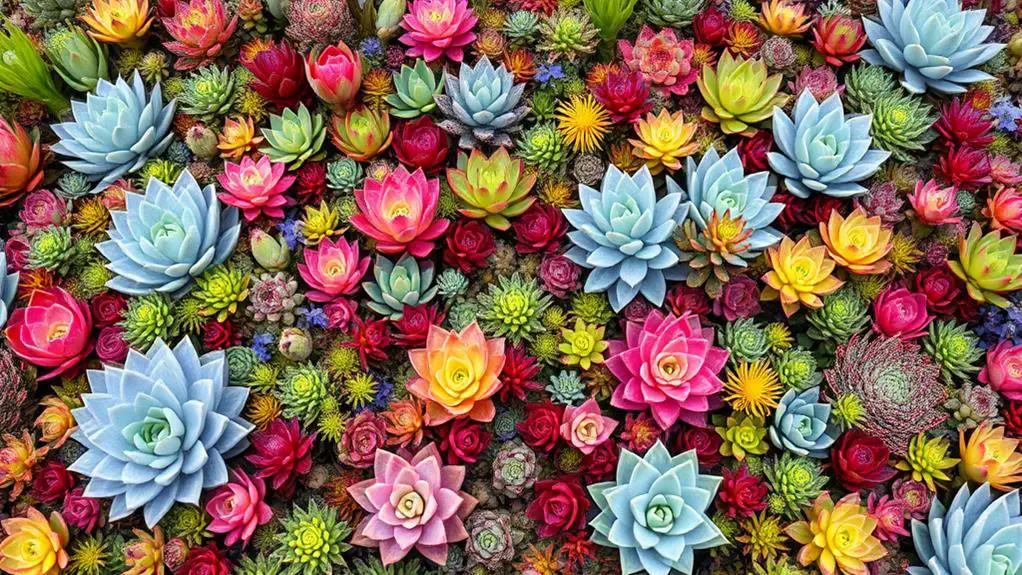
Crowded succulent arrangements can be striking, but they require specific care to guarantee the plants thrive. To achieve the right balance, aim for a spacing of half to one inch between each succulent. This allows for healthy growth while keeping your display attractive. Remember, crowded arrangements look full initially, but limited space can slow root expansion.
Using decorative rocks can enhance the look of your arrangement. They fill empty spaces and give a polished appearance as your succulents grow. Expect your crowded arrangement to fill in between 2 weeks to 3 months, depending on the plant varieties.
Regular maintenance is key. Careful watering is vital—succulents don't like too much water, especially in tight spaces. Also, be prepared to prune occasionally to manage overgrowth and prevent root binding.
Here's a quick guide to help you:
| Tip | Why It's Important | How to Do It |
|---|---|---|
| Spacing | Guarantees healthy growth | Leave 0.5 to 1 inch gap |
| Decorative Rocks | Enhances visual appeal | Place between plants |
| Regular Maintenance | Promotes long-term health | Water carefully, prune |
| Root Expansion | Prevents root binding | Monitor and adjust |
Outdoor Planting Guidelines
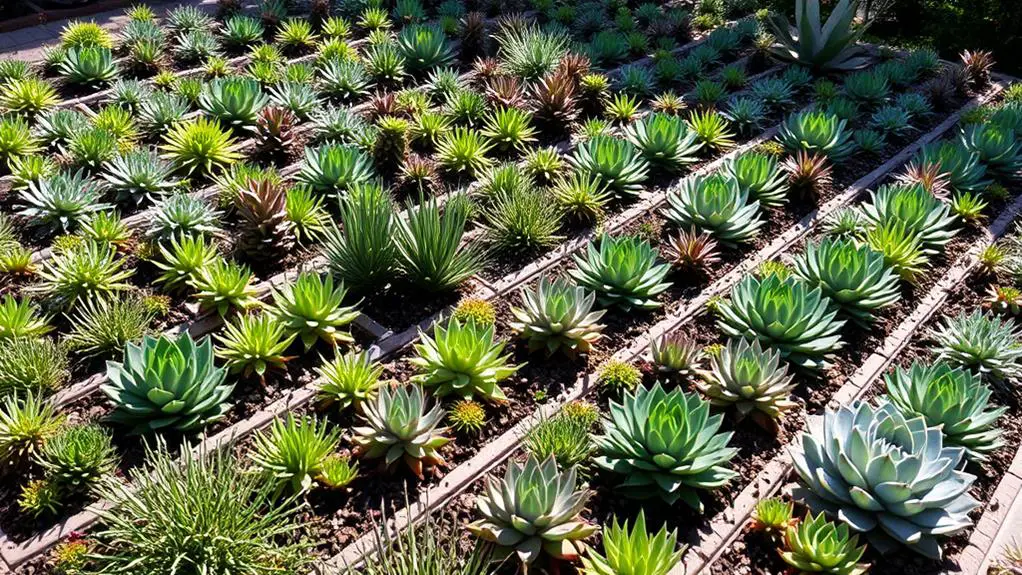
Planting succulents outdoors requires thoughtful spacing to guarantee they thrive. When you're planting these resilient plants in your garden, it's important to leave 1 to 3 inches of space between each one. This spacing helps them grow to their full potential and assures peak health.
Initially, your arrangement might look a bit sparse, but don't worry—succulents will fill in beautifully over time. Outdoor succulents tend to grow faster than indoor ones because they get more sunlight and have more room to spread out.
Here are a few tips to help you plan your outdoor planting:
- Allow 1 to 3 inches of space: This promotes healthy root development and prevents overcrowding.
- Plan for future growth: Consider how large each plant will get, and adjust your spacing accordingly.
- Enhance visual impact: Proper spacing will make your garden look fuller and more attractive as the plants mature.
- Understand growth habits: Different succulents have different needs; make sure they're compatible in your arrangement.
- Promote peak health: Adequate spacing reduces competition for resources like water and nutrients.
Benefits of Close Planting
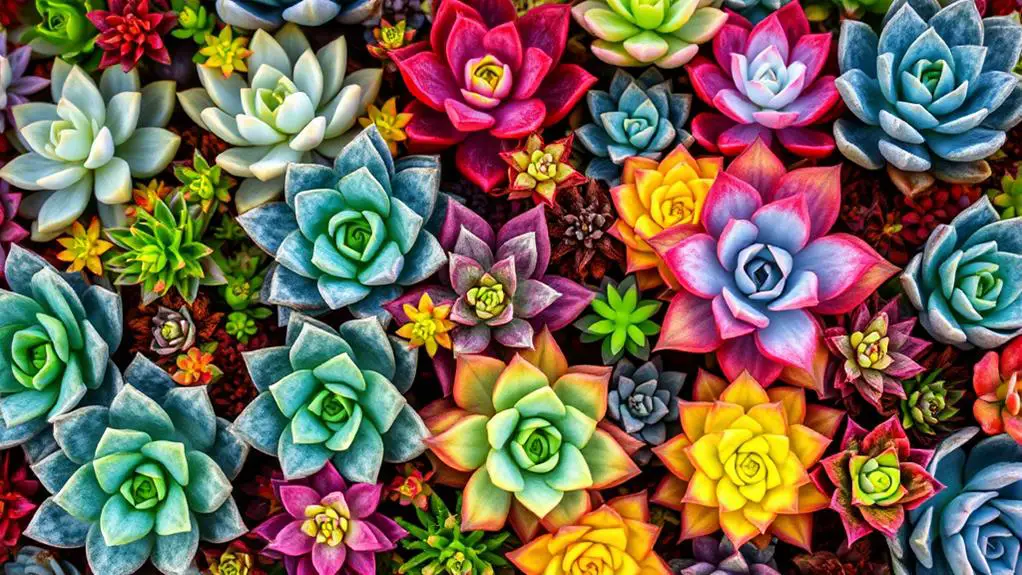
Close planting of succulents offers several compelling benefits that make it a popular gardening technique. When you arrange succulents closely, they efficiently utilize available resources like soil, moisture, and nutrients. This is similar to how goldfish adapt to their environments.
Close planting means your plants grow at a slower rate because of the competition, which helps prevent overgrowth and keeps your succulent arrangement looking tidy for longer.
One major advantage of close planting is that it creates a visually appealing arrangement. When succulents are packed tightly, the display looks full and vibrant from all angles. This effect is often more striking than having multiple individual pots. Varieties like Sedum can spill over the edges, adding to the lush and dynamic appearance of your planter.
Additionally, with proper care, such as watering your succulents appropriately, these arrangements can maintain their shape and appearance for over a year. Close planting helps your succulents thrive together, making the most of the space and resources available.
This method is perfect for creating eye-catching displays that are both beautiful and sustainable.
Downsides to Close Planting

When you plant succulents too close together, watering can become a hassle since the roots are hard to reach, and they mightn't get enough water.
Also, overgrown succulents can make your planter look messy and crowded.
It's important to remember that tight planting needs extra care to keep everything healthy and looking good.
Watering Challenges
Densely packed succulents pose major watering challenges that can jeopardize their health. When you plant succulents too close together, it becomes hard to guarantee all roots get adequate moisture. Overcrowded arrangements can result in uneven moisture distribution, where some plants might receive too much water while others stay dry. This can make watering a real headache.
Using small spout watering cans or squeeze bottles can help with precise watering, targeting the soil line to avoid drenching the plant crowns. However, even with these tools, it's tricky to manage water pooling, which can lead to root rot if drainage isn't sufficient or if you water too often.
To manage these challenges, keep an eye on your plants for signs of overwatering or stress. Regular monitoring is key to maintaining plant health in crowded conditions.
Here are some tips to help you:
- Use small spout watering cans: This helps with precise watering.
- Target the soil line: Avoid soaking the plant crowns.
- Check drainage: Guarantee the soil drains well to prevent root rot.
- Monitor signs of stress: Look for yellowing leaves or mushy stems.
- Water less frequently: Succulents don't need much water.
Overgrown Appearance
You'll quickly notice that tightly packed succulents often develop an overgrown and unkempt appearance. When your plants are too close together, they can outgrow their containers faster, leading to a messy look.
Overcrowding can cause some succulents to become root-bound, which affects their health and growth potential. In a crowded setting, the competitive environment makes it harder to water each plant effectively, leading to uneven moisture distribution.
As your succulents grow, the arrangement might become visually imbalanced. Some plants can overshadow others, making the overall display less appealing.
This lack of aesthetic balance can be disappointing, especially if you've put effort into creating a beautiful arrangement.
Maintenance also becomes more complex in these tightly packed conditions. You'll need to carefully remove and prune overgrown plants to keep the arrangement looking its best.
This extra effort can be time-consuming and might require more gardening skills than initially expected.
Spread Out Advantages

By spreading out your succulents, you'll encourage larger growth since the plants have more room to expand their roots and access nutrients.
This extra spacing also means easier access for watering, helping each succulent get the moisture it needs without water pooling.
Plus, with enough space, your succulents are more likely to produce new offsets, adding to the beauty of your arrangement.
Encourages Larger Growth
When you spread out your succulents, you're setting the stage for faster growth and larger plants. By giving each plant enough space, you reduce competition for essential resources like soil, water, and nutrients. This extra room allows roots to spread out and grow strong, leading to healthier succulents.
Spacing your plants properly, usually around 1/2 to 1 inch apart, also improves air circulation. Good airflow is vital for preventing rot and keeping your succulents healthy. When there's enough space, your plants can develop more offsets and new growth, creating a fuller, vibrant display over time.
Here are some benefits of spreading out your succulents:
- Better air circulation: Helps prevent rot and supports healthy growth.
- Stronger root systems: Roots can spread out and access more nutrients.
- Less competition: Each plant gets its fair share of soil and water.
- More space for new growth: Encourages the development of offsets.
- Healthier plants overall: Leads to larger, more robust succulents.
Although your succulent arrangement might look a little sparse at first, be patient. As your plants grow and fill in the gaps, you'll have a beautiful, lush display that shows off your gardening skills.
Easier Water Access
Spacing out your succulents offers significant benefits for water access. When you give your plants adequate space, it's easier to water them effectively. You can use a watering can or hose without worrying about water pooling around the crowns of tightly packed plants. This helps reduce the risk of rot, ensuring your succulents stay healthy.
With more room between your plants, better airflow is achieved, which is essential for preventing moisture buildup. This promotes healthier root growth and discourages fungal issues. Each succulent can breathe better, leading to a happier and thriving garden.
Spacing also makes it easier to monitor each plant's individual watering needs. Not all succulents need the same amount of water, so being able to see and reach each one helps you tailor your care. This attention to detail supports each plant's unique requirements, promoting overall garden health.
Additionally, proper spacing encourages deeper root growth. When succulents aren't competing for space, their roots can spread out more, allowing them to absorb nutrients and water more efficiently. This results in stronger, more robust plants that can better withstand periods of drought.
New Offsets Likely
As your succulents have more room to grow, you'll notice quicker growth and larger plants. By spacing them properly, you give each plant better access to essential resources like soil, moisture, and nutrients. This means your succulents can thrive without competing against each other.
When you leave 1/2 to 1 inch between each succulent, you'll see new offsets emerging more often. These new offsets will lead to a fuller and healthier display over time, creating a lush arrangement.
Here are some key benefits of proper spacing for your succulents:
- Better growth: More space allows succulents to expand and grow larger.
- New offsets: With less competition, new offsets are more likely to develop.
- Resource access: Each plant can access the soil, moisture, and nutrients it needs.
- Easier watering: Proper spacing helps guarantee roots are soaked adequately, reducing overwatering risk.
- Lush arrangement: Although it may look sparse at first, properly spaced succulents will fill in beautifully.
Giving your succulents enough space guarantees they can reach their full potential. You'll end up with a vibrant, thriving garden that will be a joy to look at every day.
Maintenance and Care

Maintaining and caring for your succulents is essential to keeping them healthy and vibrant. When planting your succulents, give them adequate space to avoid root binding. Regularly check for overwatering signs, as succulents are prone to root rot. Use the chopstick method to monitor soil dryness. Insert a chopstick into the soil; if it comes out dry, it's time to water. Always guarantee succulent soil is completely dry before rehydrating.
A squeeze bottle helps you water precisely at the soil line, preventing water accumulation in the plant crowns. This avoids leaf rot. Prune tightly packed succulents to allow each plant enough space to grow and access resources. Delay watering for a few days after planting to let roots heal and establish in their new environment.
Here's a quick reference table to help you with succulent maintenance and care:
| Task | Frequency | Method |
|---|---|---|
| Checking for pests | Weekly | Inspect leaves and soil for bugs |
| Watering | When soil is dry | Use chopstick method and squeeze bottle |
| Pruning | As needed | Trim overgrown or tightly packed plants |
| Soil monitoring | Before watering | Assess pot weight and use chopstick to check soil dryness |
Frequently Asked Questions
Do Succulents Like to Be Planted Close Together?
Yes, succulents can be planted close together. They utilize resources efficiently and maintain their shape longer. Just guarantee a spacing of half to one inch to allow for healthy growth and a visually appealing arrangement.
How Far Apart Should I Plant Succulents?
You should plant succulents half to one inch apart in containers. For outdoor spaces, increase the gap to 1 to 3 inches. This spacing promotes healthy growth and prevents root binding, ensuring long-term plant health and aesthetics.
Can You Plant Multiple Succulents Together?
Yes, you can plant multiple succulents together. Just guarantee they share similar light and water needs. Leave half to one inch of space between them for healthy growth. Manage crowding to create a beautiful display.
Will Succulents Spread on Their Own?
Yes, succulents will spread on their own. Many produce offsets that enhance your arrangement over time, while trailing varieties naturally extend. Adequate spacing and regular maintenance will help them thrive and fill in spaces effectively.
Conclusion
Planting succulents can be easy and fun if you remember a few key points. Space them 0.5 to 1 inch apart during spring and summer for healthy growth. In fall and winter, closer planting works fine. By paying attention to their needs, you'll have a thriving, beautiful garden. Don't worry; with a little care and attention, your succulents will do great. Enjoy the process and watch your plants flourish!

